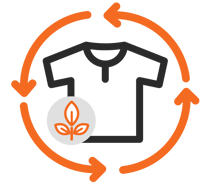Do you sell sustainable and ethical cloting through online marketplaces like Zalando? Then it's good to be aware of the so-called 'attitude-behaviour gap'. Many consumers indicate that they want to make sustainable and ethical choices in fashion. Yet in practice, we see that very few of these consumers actually consistently choose sustainable and ethical clothing. This 'gap' between what people think and what they actually do is discussed in Zalando's 'Attitude-Behaviour Gap-rapport’.
In this article, we summarize the main findings of this report. We discuss what exactly the attitude-behaviour gap is, what it means for sellers of sustainable and ethical clothing, and how to bridge this 'gap'.
Content article:
- What is the Attitude-Behaviour Gap in Fashion?
- The research by Zalando
- The results of the Additude-Behaviour Gap report
- Seven themes is consumer behaviour
- What does this mean for sellers of sustainable and ethical clothing?
- This is how you bridge the attitude-behaviour gap: 10 recommendations
Do you want to know more about selling on Zalando or do you want to discuss the possibilities for you brand? Click on the arrow below and get in touch with one of our specialists!
What is the Attitude-Behaviour Gap in Fashion?
The attitude-behaviour gap also referred to as the value-action gap or the intention-behaviour gap, refers to the "gap" that occurs when an individual's values or attitudes do not (completely) match his or her behaviour.
We also see this gap when it comes to purchasing fashion. More and more consumers are aware of the importance of sustainable clothing. Especially younger shoppers (millennials and generation Z) indicate that they consider sustainability important when buying clothes. And although we see this reflected in the popularity of brands that profile themselves as 'sustainable', there is still a skewed ratio between the percentage of consumers who say they care about sustainability and the percentage of consumers who actually store sustainably.
We see the same when it comes to the importance of ethical clothing. Although consumers indicate that they want good working conditions for the people who make their clothes, we do not always see this reflected in their buying behaviour.

The research by Zalando
Zalando's 'Attitude-Behaviour Gap report' examines consumers' attitudes and behaviours toward sustainable and ethical fashion. The study identified 12 elements that play a role in consumers' attitudes towards sustainability, ethical responsibility, and fashion:
- quality of the product
- the price-quality ratio of the product
- price premium (price relative to similar products)
- brand responsibility (how sustainable/ethical is the brand, rather than this individual product)
- manufacturing (the way the product is made)
- working conditions for people who worked on the product
- individual responsibility
- influencers
- used clothing
- repair of clothing
- Throwing away or giving away clothes
- transparency (how open is the brand/company about sustainability and working conditions?)
Based on these 12 elements, surveys were conducted among 2500 people in the UK, Sweden, Italy, France, and Germany. The participants were 50% gen Z (between 18 and 24 years old) and 50% millennials (between 25 and 35 years old). Half of the participants were male, the other half female. There was also a lot of variation in education level and income between the participants.
The surveys asked two questions for each of these 12 elements:
- How important is this element to you when buying fashion?
- How often do you do the following... (for example: check the origin of a product)?
The results of the Attitude-Behaviour Gap report
Now that you know what the attitude-behaviour gap means, it won't surprise you that the study found that the answers to the first and second questions show a distinction between what people say they think is important and their behaviour.
Yet the gap between attitude and behaviour was not the same for all elements. Sometimes the gap was small. For example, when it came to product quality, 58% of participants said they thought sustainable quality was important (the clothes should last a long time) and 52% of participants, therefore, take this into account when they buy clothes.
Other times, the gap was actually very wide. For example, about 60% of respondents indicated that they find transparency about sustainability important, while only 20% actively seek sustainability information during the purchasing process. About 53% of the participants indicated that they thought an ethical labor policy was important, while only 23% actually investigate the policy.
Also, some 60% of participants indicated that they value second-hand clothing and repairing broken clothing. Yet only 23% of the participants repair their own clothing and only 25% of the participants actually buy secondhand.
Seven themes in consumer behaviour
The study also revealed seven key themes in consumer behaviour:
- Consumers think sustainability is important, but buying sustainable clothing is not yet high on their priority list for many consumers.
- Sustainability comes after value, quality, and fit.
- Discounts can lead to overconsumption, which in turn leads to buyer regret.
- Consumers see many influencers as not credible when it comes to sustainability.
- Consumers do not have a good understanding of the value of a product at the 'end' of its life; they throw away many valuable clothes.
- The popularity of second-hand clothing is increasing but still does not make it to new clothing.
- Consumers want to keep clothes longer but have insufficient knowledge about care and repair.
What does this mean for sellers of sustainable and ethical clothing?
Do you sell sustainable and ethical clothing? Then you may have a tendency to take these results very negatively. Consumers indicate that they find sustainability and ethical responsibility important, but ultimately do not act upon them, which is perhaps your conclusion.
Still, you don't have to shut down your business right away. Don't forget that the research also shows that consumers do consider sustainability and ethical responsibility very important when buying clothing. In other words, the values of these consumers actually fit your company and your product very well.
The problem lies in the implementation: consumers have to make various efforts to find out how sustainable their clothes are and what the working conditions are of the people working on their clothes. Zalando's research shows that consumers expect the industry to help them make these efforts. More than half of the participants said they think it is important that brands, online platforms, and sellers take the pressure off them, by taking measures towards sustainability.
In addition, more than half of the consumers themselves want to feel like they can influence the sustainability of fashion. In other words, to bridge the attitude-behaviour gap, you need to work with your customer.
This is how you bridge the attitude-behaviour gap: 10 recommendations
As a salesperson, it is therefore important to help consumers bridge the attitude-behaviour gap.
As a result of the research and several conversations with their sales partners, Zalando gives the following 10 recommendations:
- Take steps to make your brand more transparent and involve your customers in this.
Increase transparency by sharing supply chain information with your customers and/or publishing photos of supplier factories on your website. Also, be open about your environmental impact and the steps you are taking to improve your business. - Speak about sustainability in simple language that everyone understands.
You can use the tools from Sustainable Apparel Coalition and Higg Index to create industry-wide sustainability standards. This makes it easier for consumers to compare the sustainability of different brands. In doing so, make sure your language in sustainability communications is easy to understand. - Help your customers get excited about your sustainability mission.
Identify and invest in the changes that will have the biggest impact on your business and your customers. Does reducing plastic make an impact, or should you focus on circularity? Once you know what mission you want to focus on, you need to clearly communicate this to the customer at different touchpoints. - Help your customers buy well, rather than buy more.
Create awareness around more sustainable products and choices and the benefits they bring. Consider the product life cycle when communicating with your customers, so they can understand the range of sustainable options available at each stage. - Use data and technology to correct unsustainable discounts.
Large discounts are interesting to customers, but often a necessary consequence of overstocking for you. Tackle overstocking and increase efficiency through better planning and streamlined operational capabilities. Start optimizing your operations with smart planning and digital systems. Invest in machine learning and AI to improve your forecasting. Take it a step further by exploring new business models, such as on-demand production capabilities. - Focus on value, quality, and fit to sell sustainable products.
As mentioned above, consumers consider the value, quality, and fit of a product more important than sustainability or ethical responsibility. Therefore, highlighting the value, quality, and fit of sustainable products help to sell more of them. For example, focus on the quality benefits of organic cotton, or communicate that your clothing is not only sustainably produced, but also long-lasting and therefore provides more value for money.
- Combine stories from influencers with stories from your customers and employees.
When you use influencers: make sure they are credible role models. Use micro-influencers and/or let employees and customers shine in your marketing campaigns. Let your company's/brand values shine through in your communications. - Integrate circularity throughout the product lifecycle.
Educate your team on circular design, combat overstocking, and test new business models such as resale or rental. Also, consider the impact of returns and try to prevent the number of returns through correct and clear information combined with clear photos.
- Invest in second-hand clothing.
Fight the stigma against second-hand clothing by presenting new and second-hand clothing together in marketing campaigns, shopping environments, and on social media. In doing so, you help customers see that second-hand is just as good as new clothing. - Help your customers care for and repair their clothing.
Stay in touch with your customers about care after purchase. Give care instructions, for example about washing or storing garments, so they last a long time. This helps your customers take care of their clothes and promotes commitment and loyalty. Do you have a physical store? Then organize an event to teach customers how to repair clothes. Finally, make it easy for customers to find repair shops or tailors nearby, for example by providing a list of recommended partners on your website.
More information about selling (sustainable) clothes through Zalando?
Do you want more information about selling sustainable and ethical clothing through Zalando? Then also read our article about the Zalando Sustainability Label. Or contact us for more information.

